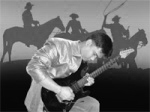 This tutorial has been shared to us by Arch.Arnel Canaleja of Eastern Visayas State University Tacloban City.
This tutorial has been shared to us by Arch.Arnel Canaleja of Eastern Visayas State University Tacloban City.Tutorial Title: Converting a day scene with night scene using Photoshop
This tutorial is advanced technique to quickly create a night scene using an image rendered in day scene.
This is the Final Scene:
Ok Let's begin
Step 1: Removing the Sky background
Loading the Image in Photoshop and begin removing the background image (the sky background).
Step 2: Creating the Diffuse Layer
Create new layer and select all the positive space (the sky is the negative space). Once selected, fill it with color like the image below.
Step3: Moving the reference image on the top layer
Send the diffuse layer at the back of reference image (perspective)
Step 4: Linear burn blending mode
Change the blending mode of the top layer into Linear burn
Step 5: The Light layer
Create a new layer. This will be the light layer. Choose a light yellowish color. This color will become the illuminated lighting in the scene.
Step 6: Painting the illuminated light source.
First, you need to put below the reference image(perspective), the"LIGHT" layer. Apply the illuminate light effect using a soft brush. You can also use the "lasso" or "rectangle marquee" tool (with feathering), to control the area where you want to apply the lighting effect. With the same techniques you can now create different layers of "LIGHTING" as needed.. You can also "blur" the other lighting layers to make it more realistic especially for the pinlights, car lights, etc.
Step7: Recreating the Background Sky
Create a new layer for your "SKY"background. Use the brush tool, or gradient tool or by pasting some night scene background (see the layer highlighted in RED).
Note:
Be sure that your sky image will not intersect with your first image (Perspective) As it will affect the color of your perspective since it is in LINEAR BURN mode.
Step 8: Windows and other openings.
For the glazings, glass windows and openings, You can copy paste some image from photos: You can also add store fronts, signage, cars, and other entourages. Of course this will vary from your choice, judgment and
creativeness.
Some useful keyboard shortcuts for this tutorial.
- . Create new layer= CNTRL+SHFT+N
- Image size= CNTRL+ALT+I
- Creating new file= CNTRL+ALT+N
- Copying an Object = click "MOVE" icon, then press / hold ALT key then (left click) drag the mouse
- Send a particular layer at the back (one step back) = CNTRL+[
- Send a particular layer at the back (at the very bottom of the layer order) = SHFT+CNTRL+[
- Send a particular layer above the stack (one step forward) = CNTRL+]
- Send a particular layer above the top stack = SHFT+CNTRL+]
- Keyboard shortcuts menu = CNTRL+SHFT+ALT+M
Arch.Arnel Canaleja aka. Arc_Can_EVSU
Eastern Visayas State University Tacloban City











No comments:
Post a Comment